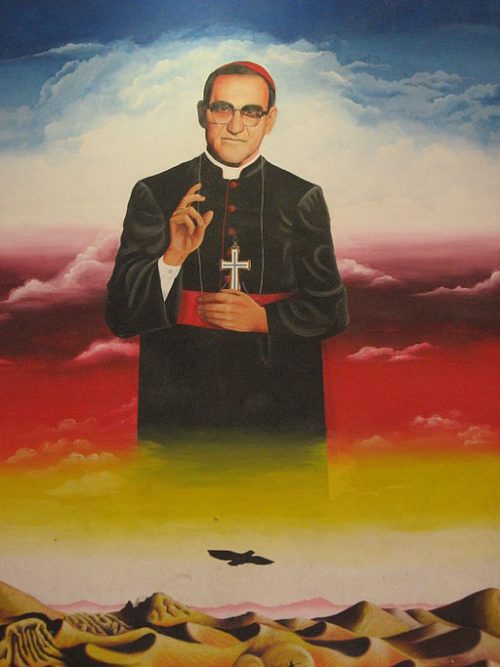It was a peaceful day in an area known for strife and murder. Inside the convent chapel, the priest elevated the host in the great moment of the mass. Suddenly a shot rang out and the priest slumped to the floor. The assassins quietly left the chapel and drove off, leaving the scene of horror for the nuns who witnessed it. The priest was the Archbishop of El Salvador, Óscar Romero, and he was dead.
Archbishop Romero was and is known in El Salvador for his fight for human and civil rights. The corrupt government of El Salvador in Romero’s time made life easy for the rich, but extremely hard for those who scrape their livings off the meager grounds that they could use. Gangs moved freely and usually with governmental permission to kidnap, rape, torture or kill almost at will. Dissension was ruthlessly stamped out. Romero fought the government and in return, he paid for it with his life.
In 1980, when Romero’s assassination occurred, the idea of a shooting in a church, especially in a Roman Catholic Church in a Roman Catholic country with the Archbishop of the country being gunned down was a horrifying story for the news to carry. Things like that just didn’t happen.
I remember soon after arriving in the Philippines in 1970 for a three-year tour with my husband, and hearing that not all that long before, the mayor of a neighboring town and part of his family were killed by insurgents who came into the church during mass, selected their targets and shot them. That was hard to believe, and that was in the 1970s and in a country where seeing people walk around with submachine guns was common. I see somewhat the same thing now, only people carrying assault weapons.
Romero was a hero to his people and, after his death, his countrymen and others within civil rights communities around the world considered him a saint for his stand against oppression and cruelty. That he should die, especially in the way that he did, just increased the visibility of the problems.
In 1997, the martyred archbishop was beatified and made a Servant of God by Pope John Paul II. Recently, Pope Francis stated that Romero would be made an official saint sometime in the next year. The road to sainthood is almost complete, but I don’t think Romero would be overjoyed. Long before the Pope declared it, he was a servant of God and a servant of his people. His life was dedicated to his flocks and they knew it. They felt the intensity of his care and his love for them, and they responded to it. They felt God working through him.
Romero was a martyr. He was doing his job. He was preaching the gospel. He was paying attention to the things that were wrong and trying to enable the kingdom of God on earth in his country. The oppression continued in El Salvador until 1992, when the government was overthrown, and the slaughter ceased. Among the dead were 75,000 according to the UN, and included Romero, four Maryknoll sisters and nine Jesuits who died two years after Romero. They are also included in the commemoration of his day as the martyrs of El Salvador.
During the upcoming holy week, we focus on the martyrdom of Jesus on Good Friday. An innocent man, falsely convicted, decried by the temple, the Romans, and ordinary people. Jesus died for his faith and for his teachings, just as Romero did. Romero’s execution took his life in a matter of heartbeats while Jesus is martyrdom took hours. While we observe Good Friday and all that it entails, perhaps looking back on the teachings of Jesus and how martyrs all around the world have met their ends violently for those same beliefs and their attempts to follow Jesus as best they understand.
This week I think I’ll remember Romero and all the martyrs for the faith who died trying to do their best to follow the will of God and to help their neighbor by loving them and caring for them. Good Friday will have an adequate memorial for the death of the One who inspired Romero and all the martyrs, and so it’s worth taking the time to see those martyrs around the foot of the cross praying, crying, and resolving to not let that death be in vain. For Romero, Easter would come, not in 1980, the year of his death, but it would come and with it the resurrection.
Have a blessed holy week.
God bless.
Image: Mural con la imagen de Monseñor Óscar Arnulfo Romero, ubicado en el Edificio Histórico de la Facultad de Jurisprudencia y Ciencias Sociales de la Universidad de El Salvador.
Authors: Douglas Radamez Barahona, Giobanny Ascencio y Raul Lemus- Grupo Cinteupiltzin CENAR El Salvador
Linda Ryan is a co-mentor for two Education for Ministry groups, an avid reader, lover of Baroque and Renaissance music, and a homebody. She keeps the blog Jericho’s Daughter. She is also owned by three cats. She has been Episcopalian for over 50 years, and is grateful God led her to the Episcopal Church in various places.

